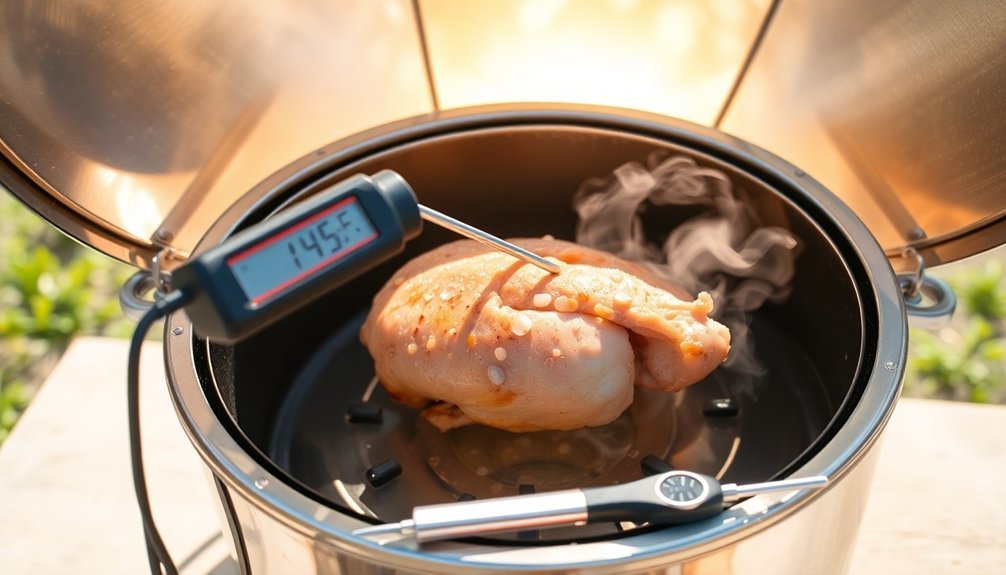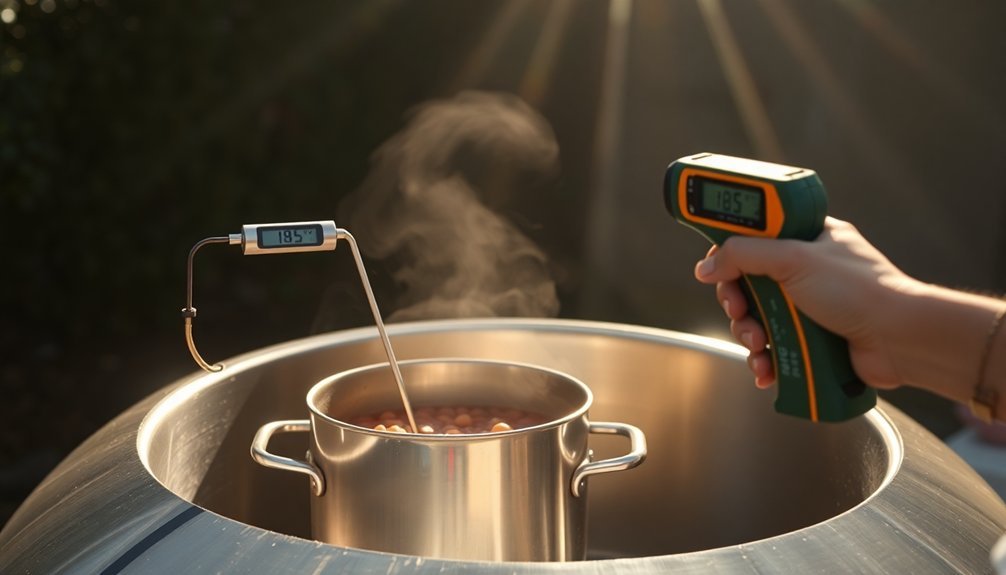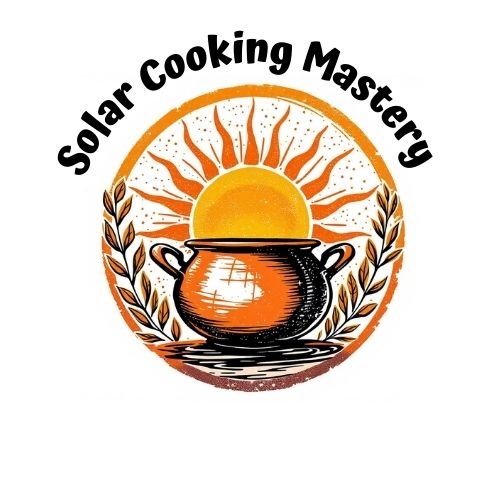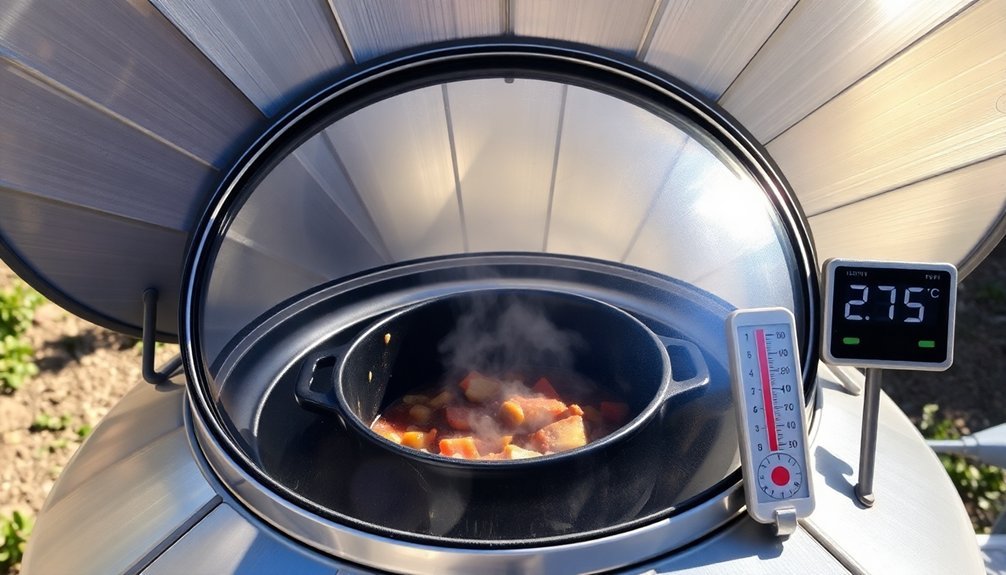Monitoring heat levels while solar cooking is vital for both food safety and ideal results. You'll need to guarantee your food reaches minimum safe temperatures – 145°F for whole meats, 160°F for ground meats, and 165°F for poultry – and maintains these temperatures for at least 15 seconds to kill harmful bacteria. Regular temperature checks help you avoid the danger zone (41°F-135°F) where bacteria thrive, prevent burning in high-heat parabolic cookers, and adjust cooking times based on weather conditions like humidity and altitude. Using tools like digital probes or infrared thermometers can make the difference between a perfect meal and a potential health risk. Let's explore the essential techniques for mastering temperature control in solar cooking.
Safe Food at Every Temperature

When it comes to safe food preparation, maintaining proper temperatures is essential for preventing foodborne illness.
You'll need to verify your food reaches specific minimum internal temperatures: 145°F for beef, lamb, pork, fish, and seafood; 160°F for ground meats; and 165°F for poultry. These temperatures must be sustained for at least 15 seconds.
Keep in mind that bacteria thrive between 41°F and 135°F, known as the danger zone.
You'll want to move food through this temperature range quickly. For hot foods, maintain them at 135°F or above; for cold items, store at 41°F or below. Using a vacuum sealer can help maintain food quality and safety during storage.
When cooling hot food, get it from 135°F to 70°F within two hours, then down to 41°F within six hours total.
Never leave food out for more than two hours at room temperature.
Perfect Timing for Solar Success
Now that you understand safe food temperatures, mastering the timing of solar cooking will help you achieve them consistently.
You'll get the best results between 11:00 am and 3:00 pm when the sun is directly overhead, though summer allows for extended hours from 10:00 am to 4:00 pm.
Start by preheating your solar oven from 10:00 am to maximize browning and heat retention. Keep in mind that high-altitude regions may require longer cooking times despite clearer skies.
Rotate your oven every 30 minutes and adjust reflectors to track the sun's position.
You'll need to adapt to seasonal changes – winter requires more frequent adjustments and longer cooking times due to the sun's lower position.
While clouds aren't deal-breakers, you'll need at least 30-45 minutes of good sunlight per hour.
Choose a sheltered spot to protect against wind, and guarantee your oven faces directly into the sun without shadows.
Maximizing Your Solar Cooker Performance

To maximize your solar cooker's performance, you'll need to focus on three critical areas: heat absorption, storage, and retention.
Start by painting your absorber plate matte black and adding booster reflectors to increase solar radiation capture, helping you reach temperatures up to 149°C. Using an improved box-type design with 20% less surface area can further enhance efficiency.
For heat storage, incorporate phase change materials like acetanilide or stearic acid, which will let you cook even after sunset. You can also use a mixture of sand and granular carbon to improve thermal efficiency.
To minimize heat loss, guarantee your cooker's edges are well-insulated and add glazing on the bottom and sides. Don't forget the aperture glazing on top to maximize solar radiation entry.
These improvements will reduce cooking time by up to 15 minutes and maintain higher temperatures, even in windy conditions.
Preventing Food From Burning
Keep your solar meals from burning by checking temperatures every 10-20 minutes with a reliable thermometer, especially when using parabolic cookers that can exceed 400°F.
You'll need to adjust your cooking times and stir foods regularly, as sun-powered cooking requires longer preparation than conventional methods.
Watch for hot spots in your black cookware by rotating dishes and reorienting your cooker to follow the sun's path, ensuring even heat distribution throughout your meal.
Temperature Check Best Practices
Successful solar cooking relies on consistent temperature monitoring to prevent burnt meals and guarantee food safety. You'll need to use digital probe thermometers and data loggers to track internal food temperatures accurately. Make sure to calibrate your sensors regularly for reliable readings.
| Temperature Check Tips | Tools Needed | Safety Targets |
|---|---|---|
| Check every 30 mins | Digital probes | Above 125°F |
| Use tight-fitting lids | Thermocouples | Boiling point |
| Minimize lid opening | Data loggers | Safe meat temps |
When checking temperatures, position your solar oven ahead of the sun's path and adjust reflectors to maintain ideal heat. Use dark metal cookware with snug-fitting lids to retain heat, and keep your ingredients in sealed containers until you're ready to cook. Don't forget to track temperature gradients across different zones to identify hot and cold spots.
Timing Your Solar Dishes
Building on proper temperature monitoring, mastering the timing of your solar dishes prevents burning and guarantees delicious results.
You'll find the most success cooking between 10:00 AM and 4:00 PM on sunny days, though these hours shift with seasons. During winter, focus your cooking between 11:30 AM and 2:30 PM when the sun's position is ideal.
To maintain consistent heat, you'll need to adjust your cooker every 20-30 minutes, especially with parabolic and panel designs.
Don't let clouds discourage you – you can still cook on partly sunny days, but expect longer cooking times. For reliability, keep fire pellets as backup during overcast conditions.
Consider precooking or using fireless cookers when sunlight is limited. Remember, summer offers extended cooking hours, while winter requires stricter timing adherence.
Managing Hot Spots Effectively
While solar cooking offers an eco-friendly way to prepare meals, managing hot spots is essential to prevent burnt food and guarantee even cooking. You'll need dark-colored cookware, preferably black cast iron or dark brown glass, to absorb heat uniformly.
Position your pot in the center of the cooker and use a high-temperature baking bag to maintain consistent temperatures.
Keep your cooker properly aligned with the sun by adjusting it periodically throughout the day. You'll want to choose a location free from tree shadows or other obstructions.
Monitor temperatures using an oven thermometer and avoid opening the lid unnecessarily, as this can disrupt heat distribution.
Line your cooker with proper insulation materials and make certain it's sealed tightly. For best results, use reflectors to concentrate sunlight evenly across your cooking surface.
Weather Impact on Heat Levels

Since outdoor cooking temperatures fluctuate based on weather conditions, you'll need to monitor and adjust your heat levels accordingly.
Weather factors like humidity, altitude, and direct sunlight can greatly impact your cooking times and food quality. High humidity speeds up cooking as moisture stays on the food's surface, while low humidity causes faster evaporation and slower cooking.
- At higher altitudes, you'll need to cook at lower temperatures for longer periods since water boils at a lower temperature.
- Check the heat index, as it can increase by up to 15°F in sunny areas compared to shaded spots.
- Position your grill away from direct sunlight to maintain stable cooking temperatures.
Remember that your grill can preheat just from sun exposure, so you'll want to factor this into your temperature management, especially when aiming for low-and-slow cooking.
Essential Temperature Monitoring Tools
You'll need reliable tools to monitor your solar cooker's temperature accurately, with digital temperature probes offering precise readings and wireless monitoring capabilities.
Manual dial thermometers provide a dependable backup option that doesn't require batteries and can withstand high temperatures.
Infrared heat guns give you quick surface temperature readings without opening your cooker, helping maintain consistent heat levels during the cooking process.
Digital Temperature Probes
To safely and effectively prepare sun-powered meals, digital temperature probes serve as indispensable monitoring tools. You'll get instant readouts of your food's internal temperature, ensuring it reaches safe cooking levels according to USDA guidelines.
These probes feature heat-resistant cords and durable stainless steel construction, perfect for sun-powered cooking methods.
- Connect to your smartphone via Bluetooth or WiFi for remote monitoring while you handle other tasks
- Set custom temperature alerts that notify you when your meal reaches the desired doneness
- Monitor multiple dishes simultaneously with multi-probe models
You won't need to lift cooking vessel lids to check temperatures, which helps maintain consistent heat levels in your solar cooker.
The probes' magnetic backs and foldable designs make them easy to position, while their wide temperature range (-10°C to 232°C) handles various cooking needs.
Manual Dial Thermometers
Manual dial thermometers provide reliable temperature readings for solar cooking without requiring batteries or digital displays. You'll find these durable instruments made from stainless steel or brass, featuring hermetically sealed designs that protect against moisture and dust. The bimetal coil inside responds to temperature changes, moving the indicator across easy-to-read Fahrenheit and Celsius scales.
| Feature | Benefit |
|---|---|
| Magnetic backing | Attaches easily to metal surfaces |
| Multiple dial sizes | Choose 1" to 5" for your needs |
| Accuracy rating | Within 1% of full scale range |
| Wide temp range | -200°C to 400°C (-100°F to 1,000°F) |
These thermometers offer various mounting options and stem lengths, making them ideal for monitoring your solar cooker's temperature. Their precision and durability guarantee consistent readings throughout your sun-powered cooking adventures.
Infrared Heat Guns
Infrared heat guns serve as indispensable tools for monitoring temperatures in solar cooking, offering precise readings without direct contact. You'll get accurate measurements within 0.5 seconds, with ±1.5% accuracy across a wide temperature range of -58°F to 1022°F.
These devices let you safely check your solar cooking temperatures from a distance using laser-guided targeting, while the backlit LCD screen guarantees easy reading in bright sunlight. You won't need to open your solar cooker and lose precious heat during temperature checks.
Key benefits for solar cooking include:
- Non-contact measurements prevent heat loss and contamination
- Adjustable emissivity settings for different cooking surfaces
- Max/min temperature tracking to monitor cooking progress
Switch between °F and °C units easily, and rely on the auto shut-off feature to preserve battery life during your sun-powered cooking sessions.
Heat Distribution in Solar Cooking

When sunlight strikes a solar cooker, it undergoes a remarkable transformation from UV rays into infrared radiation that powers the cooking process. The infrared waves cause food's water, fat, and protein molecules to vibrate, creating the heat needed for cooking.
You'll get the best heat distribution by using dark-colored surfaces inside your cooker, as they maximize heat absorption while light colors reflect energy away.
To maintain consistent temperatures, you'll need to adjust your reflector panels every 1-2 hours as the sun moves. These panels, made from materials like aluminum or chromium, concentrate sunlight onto your cooking area.
A clear lid and proper insulation create a greenhouse effect that traps heat inside, helping you maintain temperatures between 200°F and 300°F – perfect for cooking most dishes safely.
Protecting Yourself While Cooking
Safe solar cooking requires protective measures to shield both your eyes and skin from potential harm.
When using a parabolic cooker, always keep your head away from the focal area and avoid looking directly at sun reflections. You'll need to be especially vigilant about keeping children at a safe distance.
To protect yourself while solar cooking, remember these essential safety measures:
- Use pot holders whenever handling cookware, as surfaces can become extremely hot.
- Position the cooker where people won't accidentally brush against hot surfaces.
- Wear appropriate protective gear during setup and cooking.
Never place your face near the focal point of a parabolic cooker, as both the intense heat and reflected sunlight can cause injury.
If you're adjusting the cooker's position, take extra care to protect your eyes and skin from exposure.
Seasonal Temperature Adjustments

Different seasons demand distinct adjustments to your solar cooking approach, as the sun's intensity and position greatly affect cooking temperatures and times.
In summer, you'll enjoy peak temperatures up to 350°F between 10 AM and 2 PM, with minimal need to reposition your cooker.
Spring offers reliable conditions, reaching 300°F during peak hours, making it perfect for quick-cooking items like eggs.
Winter requires more strategic planning – cook between 11 AM and 3 PM, use additional insulation, and expect longer cooking times due to the sun's lower position.
Fall presents the biggest challenges, with temperatures typically hovering between 140-160°F.
You'll need extra patience as cooking times lengthen considerably.
Remember to adjust your cooker's angle seasonally and consider using thermal mass like rocks or bricks to maintain consistent heat levels.
Frequently Asked Questions
Can Colored Cookware Affect Heat Absorption in Solar Cooking?
Yes, the color of your cookware greatly impacts solar cooking. You'll find dark-colored pots absorb more sunlight and heat up faster, while light-colored ones reflect heat away, making your cooking less efficient.
How Does Altitude Impact Solar Cooking Temperatures and Times?
At higher altitudes, you'll experience faster cooking times and hotter temperatures since there's less atmosphere to block solar rays. You'll get more direct sunlight, which means more efficient heating of your solar cooker.
Do Different Food Textures Require Different Heat Monitoring Approaches?
Yes, you'll need distinct monitoring approaches: check delicate foods like fish more frequently, while dense foods like stews need longer, steady monitoring. Quick-cooking items require close attention to prevent burning.
What Emergency Backup Methods Exist if Solar Temperatures Suddenly Drop?
You'll want to keep portable gas stoves, camping stoves, or charcoal grills ready as backup. They're reliable alternatives when solar cooking fails. Don't forget battery-powered options and electric cooktops for emergencies.
How Do Electromagnetic Fields From Nearby Electronics Affect Solar Cooking Temperatures?
You don't need to worry about electromagnetic fields from nearby electronics – they won't affect your solar cooker's temperature at all. The cooking process relies solely on sunlight and isn't impacted by electronic devices.
In Summary
You'll get the most out of your solar cooking by staying on top of heat levels throughout the process. Keep a thermometer handy, adjust your cooking times based on weather conditions, and always guarantee food reaches safe temperatures. Whether you're baking bread or simmering stew, proper temperature monitoring isn't just about successful meals – it's about your safety and getting consistent results from your solar cooker.





Leave a Reply